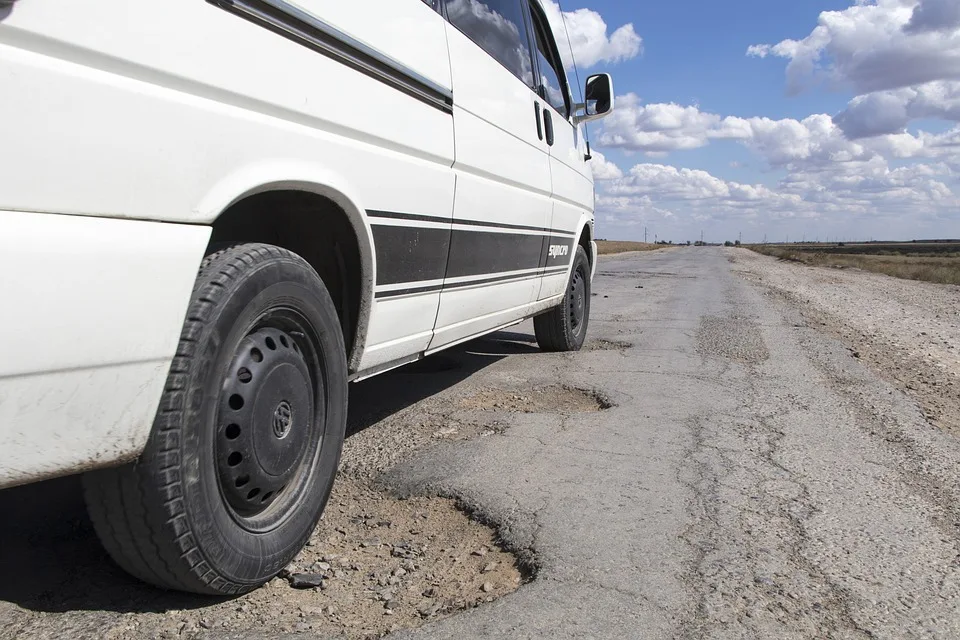As a driver, you need to always stay alert for any potential road hazards. You also need to take a leaf out of excellent drivers’ books to tackle them in the right way and ensure you – and others – stay safe.
So, let’s take a look at four common hazards to watch out for.
1. Potholes: The Sneaky Suspension Snappers
Let’s chat about potholes — those treacherous asphalt pits that seem to play peek-a-boo with your car’s suspension. They’re not just an annoyance; they can cause real damage, from punctured tires to wrecked alignments.
So, what do you do? Pro drivers keep eagle eyes on the road ahead, scanning for these sneaky snappers.
To deftly dodge them without swerving into a Broadway rendition of Frogger, slow down but stay steady—no sharp turns! If a pothole ambush is unavoidable, ease up on the brakes right before impact. It sounds counterintuitive, but braking hard compresses the suspension, which means less give when you hit that crater.
And here’s an extra tip: make sure your tires are always correctly inflated because proper air pressure gives them a fighting chance against those asphalt abysses. There are lots of different types of road defects out there besides potholes – including trees blocking the road and dangerous medians – so use the same method to avoid hitting trouble.
However, if you are involved in an accident involving a road defect, you may have the opportunity to claim compensation.
For example, if you end up being injured in a car accident in Fort Lauderdale, Florida, as a result of road defects like potholes, you could receive compensation to cover things like medical bills and lost wages – with the assistance of an experienced and skillful local lawyer.
2. Fog: The White Curtain of Confusion
Fog rolls in thick and fast, dropping a white curtain that can turn driving into guesswork. Your headlights? They’re about as useful as sunglasses at midnight when it comes to piercing through foggy conditions.
So, make sure you follow in the footsteps of excellent drivers. They use the fog-fighting strategy of flipping on their fog lights or using low beams — as high beams will only bounce back and create a glare boomerang.
Slow your roll, too, so you’ve got ample time to respond to surprises. And use the right edge of the road or painted road markings as a guide rather than relying solely on the car ahead; tailgating is never cool, especially not in this cloudy chaos.
3. Black Ice: The Invisible Slide Trap
Black ice is a thin and nearly transparent layer of ice on the road. It’s deceptively dangerous because it’s hard to spot until you’re literally on thin ice. It particularly loves to lurk on bridges, overpasses, and shaded areas.
So how do you spar with something you can’t see?
Top-notch drivers swear by a little thing called anticipation. When the temperature dips toward freezing, they slow it down, keep maneuvers gentle, and don’t perform sudden moves on the pedals—be it gas or brake.
4. Wildlife Crossings: The Unpredictable Critter Dash
Lastly, driving through areas that are popular with wildlife is like entering a surprise party — you never quite know when an animal is going to pop out. A deer or a raccoon might decide it is time for their close-up, and suddenly, they’re in your path.
Ace drivers handle these critter dash hotspots with a mix of vigilance and readiness. They keep those peepers peeled for reflective eyes on the roadside when light rays hit them. Plus, they take note of animal crossing signs and stay extra alert in those zones.
And should an animal leap onto the road, it’s about staying as calm as a cucumber while braking firmly but not swerving — as that can lead to worse outcomes like flipping your vehicle or hitting another car.
Remember, sometimes furry friends lack road smarts, so drive prepared!






